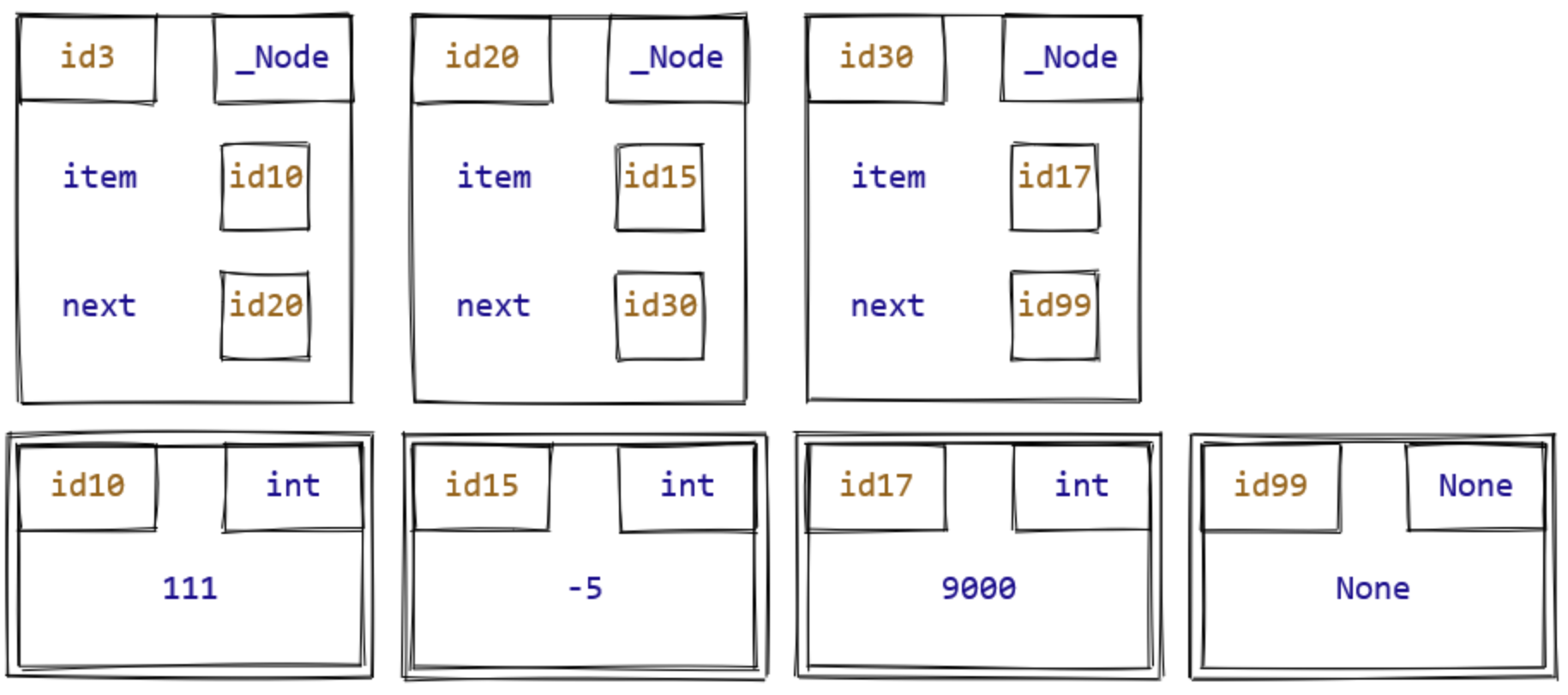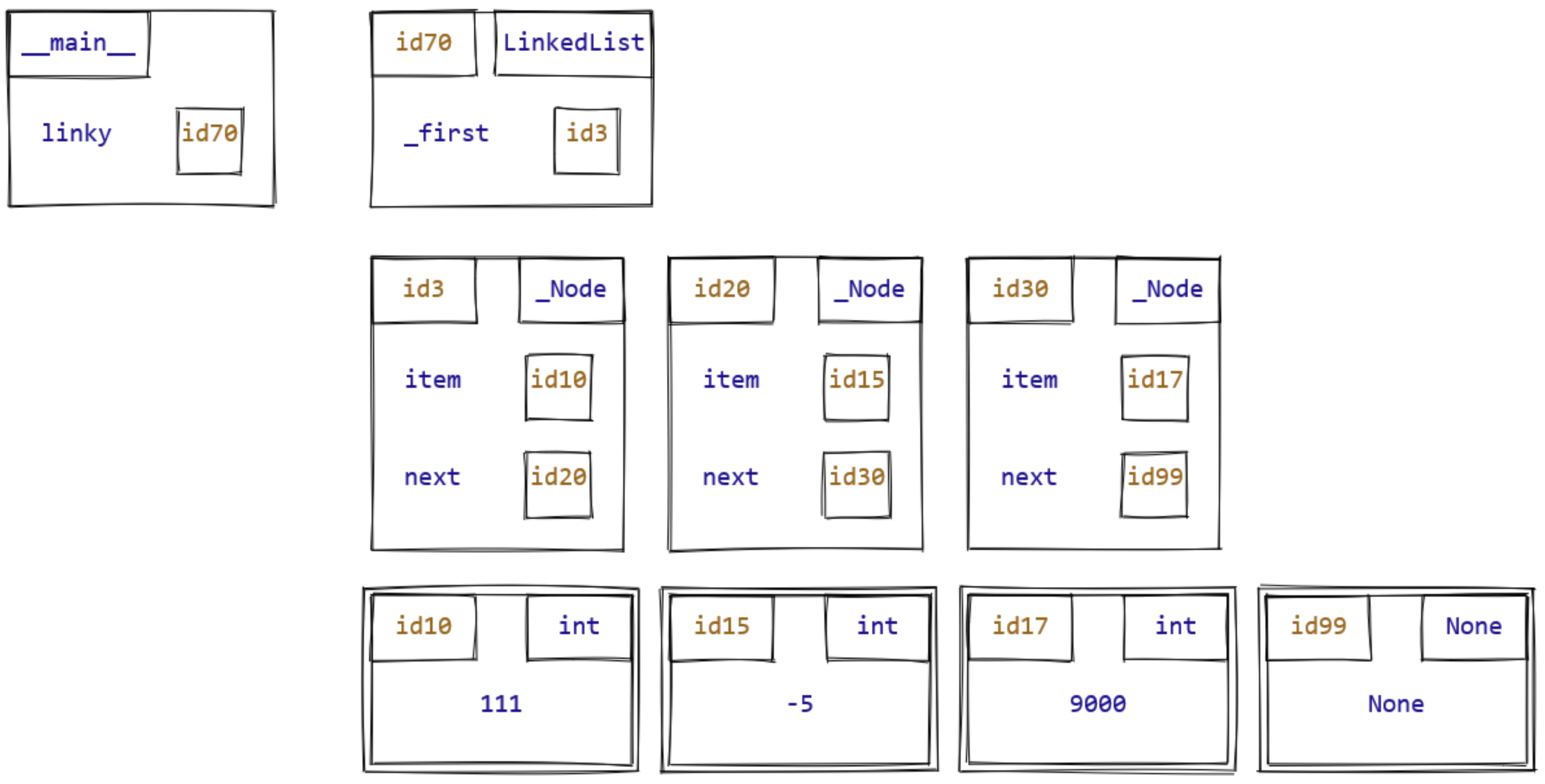Back in Section
9.7, we learned that Python lists are an array-based
implementation of the List abstract data type. This means they have some
efficiency drawbacks: inserting and deleting items in a Python
list can require shifting many elements in computer memory.
In the extreme case, inserting and deleting at the front of a
Python list takes \(\Theta(n)\) time, where \(n\) is the length of the list,
because every item in the list needs to be shifted.
In this chapter, we’re going to study a different implementation of
the List ADT that will attempt to address this efficiency shortcoming.
To do so, we’ll use a new data structure called the linked
list. Our goal will be to create a new Python class that
behaves exactly the same as the built-in list class,
changing only the private implementation of the class. This will mean
that, ultimately, code such as this:
for i in range(0, n):
nums.append(i)
print(nums)will work whether nums is a Python list or
an instance of the class we are going to write. We’ll even learn how to
make list indexing operations such as nums[0] and
nums[3] = 'spider' work on instances of our class!
Specifying order through links
The reason why Python list operations often require
elements to be shifted back and forth is that the (ids of) the list’s
elements are stored in contiguous locations in computer memory.
What if we didn’t attempt to have this contiguity? If we had a variable
referring to the first element of a list, how would we know where the
rest of the elements were? We can solve this if we store along with each
element a reference to the next element in the list.
This bundling of data—an element plus a reference to the next element–should suggest something familiar to you: the need for a new data type whose instance attributes are exactly these pieces of data. We’ll call this data type a node, and implement it in Python as follows: We use a preceding underscore for the class name to indicate that this entire class is private: it shouldn’t be accessed by client code directly, but instead is only used by the “main” class described later on in this section.
from __future__ import annotations
from dataclasses import dataclass
from typing import Optional
@dataclass
class _Node:
"""A node in a linked list.
Instance Attributes:
- item: The data stored in this node.
- next: The next node in the list, if any.
"""
item: Any
next: Optional[_Node] = None # By default, this node does not link to any other nodeAn instance of _Node represents a single
element of a list; to represent a list of \(n\) elements, we need \(n\) _Node instances. The
references in all of their next attributes link the nodes
together into a sequence, even though they are not stored in consecutive
locations in memory. It is these references, or “links”, which give
linked lists their name.
For example, here are three _Node objects that could
represent the sequences of numbers 111, -5, 9000.

Given a bunch of _Node objects, we can follow each
next attribute to recover the sequence of items that these
nodes represent. But how do we know where the sequence starts? Or put
another way, in our above example how do we know there isn’t another
_Node object in memory whose next attribute
refers to id3?
Aside: what is
__future__?
You might have wondered about the top-level import statement in the
above code, from __future__ import annotations. This is a
technical import for Python that allows us to refer to a class in a type
annotation within the body of that class. This is necessary in our case
because the _Node class has an attribute,
next, whose type annotation includes
_Node.
The LinkedList class
The second class we’ll use in our list implementation is
LinkedList, which will represent the list itself. This
class is the one we want client code to use, and in it we’ll implement
methods that obey the same interface as the built-in list
class. Our LinkedList class has a private attribute
_first that refers to the first node in the list—this is
how we know where the list starts, to answer our question above.
Our first version of this class has a very primitive initializer that always creates an empty list.
class LinkedList:
"""A linked list implementation of the List ADT.
"""
# Private Instance Attributes:
# - _first: The first node in this linked list, or None if this list is empty.
_first: Optional[_Node]
def __init__(self) -> None:
"""Initialize an empty linked list.
"""
self._first = NoneExample: building links manually
Of course, in order to do anything interesting with linked lists, we need to be able to create arbitrarily long linked lists! We’ll see more sophisticated ways of doing this in subsequent sections, but for practice here we’ll violate privacy concerns and just manipulate the private attributes directly.
>>> linky = LinkedList() # linky is an empty linked list
>>> linky._first is None
True
>>> node1 = _Node(111) # New node with item 111
>>> node2 = _Node(-5) # New node with item -5
>>> node3 = _Node(9000) # New node with item 900
>>> node1.item
111
>>> node1.next is None # By default, new nodes do not link to another node
True
>>> node1.next = node2 # Let's set some links
>>> node2.next = node3
>>> node1.next is node2 # Now node1 links to node2!
True
>>> node1.next.item
-5
>>> node1.next.next is node3
True
>>> node1.next.next.item
9000
>>> linky._first = node1 # Finally, set linky's first node to node1
>>> linky._first.item # linky now represents the list [111, -5, 9000]
111
>>> linky._first.next.item
-5
>>> linky._first.next.next.item
9000Warning: The most common mistake students make when
first starting out with linked lists is confusing an individual
_Node object with the item it stores. So in the example
above, there’s a big difference between node3 and
node3.item: the former is a _Node object
containing the value 111, while the latter is the
int value 111 itself!
>>> node3
_Node(item=9000, next=None)
>>> node3.item
9000As you start writing code with linked lists, you’ll sometimes want to operate on nodes, and sometimes want to operate on items. Making sure you always know exactly which type you’re working with is vital to your success.
Linked list diagrams
The following is a diagram illustrating our above linked list
example, with a variable linky referring to a
LinkedList object representing the sequence
111, -5, 9000. (We’ve omitted the other variables
node1, node2, and node3.)

Because each element of a linked list is wrapped in a
_Node object, complete memory model diagrams of linked
lists are quite a bit larger than those corresponding to Python’s
array-based lists. While memory model diagrams are always a useful tool
for understanding subtle memory errors—which certainly come up with
linked lists!—they can be overkill if you want a quick and dirty linked
list diagram. So below we show a stripped down version of this memory
model diagram, writing the values of each item within the node boxes and
using arrows to represent next attribute references. Note
that we use a separate arrow from a smaller box representing the
_first attribute of a LinkedList.
